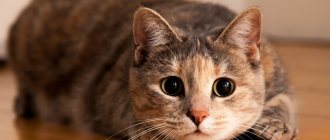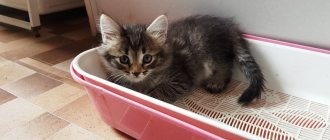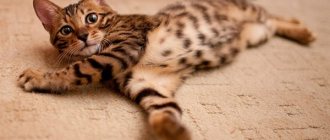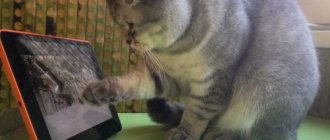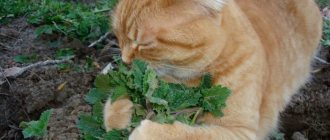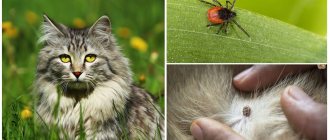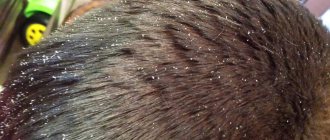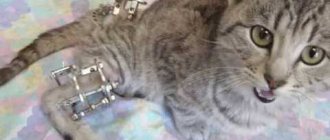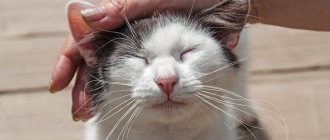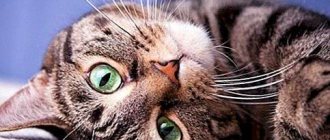Fat deposition and an increase in normal body weight lead to the development of obesity in cats. The mustache becomes inactive, and its condition worsens over time. Chronic diseases begin to appear.
The reasons for excess kilograms can be different: from overeating to taking hormonal drugs. The owner’s task is to find out the cause and help the cat restore its normal physical form.
Consequences of obesity in cats
Many pet owners rejoice when their pet's silhouette is rounded. They think it's cute and funny. But obesity does not have the best effect on the condition of cats. Fat deposition leads to many disorders and diseases:
- liver pathologies;
- fatty degeneration of organs, when lipids are deposited on the heart, kidneys, pancreas;
- diabetes;
Excess weight provokes the development of diabetes
- diseases of the musculoskeletal system - arthritis, arthrosis, spine pathologies;
- idiopathic cystitis;
- urolithiasis disease;
- impaired cardiovascular activity, thrombosis, weakness of the heart muscle;
- pulmonary failure;
- oxygen starvation;
- formation of cholesterol plaques in blood vessels, atherosclerosis.
Reference. Idiopathic cystitis is associated with dysfunction of the urinary tract. The disease is manifested by difficulty urinating, blood in urine, ignoring the tray, etc. In males, complete blockage of the urethra is possible.
Problems with joints force the animal to lead a sedentary lifestyle. As a result, body weight increases even more, and the circle closes.
A sick pet brings a lot of trouble and anxiety to its owners and mistresses. Read our article and find out what diseases cats have and what signs indicate health problems in a cat.
In addition, behavior changes. The cat becomes apathetic and lazy. At the same time, unmotivated aggression towards the owners or surrounding animals may also appear.
An overweight cat becomes lethargic
An obese cat tolerates surgery and anesthesia less well. Excess weight affects the ability to conceive and bear offspring, and complications during childbirth. The animal looks unkempt because it is unable to take care of its cleanliness.
Video - Obesity in cats and dogs
What to do?
How to deal with obesity in a cat? The first step is to seek help from a veterinarian. This is necessary in order to exclude diseases (chronic or associated with the endocrine glands). The veterinarian will recommend how and what exactly to feed an obese pet.
Don't expect miracles that your cat will quickly lose weight and become slender if she is overweight. No. The kilograms should go away gradually - and this will be a normal process of losing weight. And the closer to normal, the slower the fat goes away.
No hunger strikes
Never starve an animal. This will not only aggravate the problem and slow down the metabolism, but will also lead to the development of other diseases (gastritis, ulcers, enteritis and others). It is better, on the contrary, to feed more often, but a little at a time. Very small portions. Roughly speaking, the daily food intake must be divided into equal portions (by the number of times you will feed, for example, 3-4).
This will cause the stomach to gradually shrink. The amount of energy needed per day will remain the same, but it will only arrive gradually. And if the body needs it, it will begin to break down its supplies. It’s as if the body understands that it no longer needs to “hamster” or store, because there will be food. This principle is called fractional. It is widely used in people suffering from excess weight.
Causes of obesity in cats
There are several causes of obesity in a cat, and sometimes they are combined.
Sterilization is a major risk factor
Owners who are not involved in breeding resort to spaying and neutering of cats. However, this category of animals is at risk. Their excess weight gain is explained by changes in hormonal levels and metabolic mechanisms. As a result, appetite can increase by 20% and calorie expenditure by 30%.
Loss of fertility increases risk of obesity
Reference. The likelihood of obesity in animals deprived of reproductive functions is 3.5 times higher than in relatives capable of reproduction.
After sterilization, the body’s adaptation period lasts 2 months. If you don't change your diet, your cat's weight can increase by one and a half times.
Cat Breeds Prone to Weight Gain
Some cats have a genetic predisposition to obesity. These are the majority of small and medium breeds. At risk are the Persians and the British, who are known gluttons and lovers of sweets and starchy foods.
Persian cats love to eat
Unbalanced diet
This is the third factor that contributes to the formation of fat deposits. When preparing a diet, owners make the following mistakes:
- feeding an animal beyond measure;
- high-calorie foods;
- indulging the whims of the cat when he begs;
- abuse of treats.
I eat without moderation!
Other reasons
Weight gain is a consequence of physical inactivity, or a sedentary lifestyle. If a cat consumes more calories than it expends, it will inevitably gain weight.
This problem also manifests itself in metabolic disorders. The disorder is caused by malfunctions in the functioning of internal organs - the pancreas and thyroid glands, the pituitary gland, and the adrenal glands.
Escape from physical inactivity
How to determine excess weight and degree of obesity
Before sounding the alarm about extra pounds on a furry pet, the owner should know how to determine the animal's level of fatness and signs of obesity.
First of all, a visual examination will help determine the degree of fatness. To do this, you should carefully look at the cat from top to bottom when it stands calmly. If the body contour resembles an elongated rectangle, with a length 2 - 3 times greater than width, then the animal has signs of exhaustion. In short-haired and hairless breeds, protruding ribs, pelvic bones, and sternocostal joints will be visible.
Under normal weight conditions, when viewed from above, the owner will find the shape of a rectangle, in which the length will not be much greater than the width. The ribs and pelvic bones are not visible at normal weight.
Signs of obesity upon visual examination
If the outline of the body contours resembles an oval or approaches the shape of a circle, the owner should sound the alarm. An overweight pet has a greatly increased abdominal volume.
The most informative way to determine a cat's fatness is to palpate it. For this purpose, the pet should be picked up and its body sequentially felt. If you are underweight, the bones protrude, and fat deposits on the chest and abdomen cannot be felt.
In normal condition, the ribs, pelvic bones and sternocostal joints can be easily felt. Feeling the abdomen, the owner notes small fat deposits in this area.
In the case where the animal’s ribs, spine, and pelvic bones are difficult to palpate, one may suspect the presence of excess weight. If the ribs and spinal column cannot be felt under a thick layer of fat, and a well-defined fat layer is observed in the chest, back and abdomen, then we are talking about obesity.
We recommend reading about diabetes in cats. You will learn about the causes and symptoms of diabetes in cats, types of diabetes, diagnosis, treatment with diet and pills. And here is more information about how to treat enlarged kidneys in a cat.
The behavior of an obese animal also changes.
The pet becomes lethargic, inactive, and does not take part in games and entertainment. The cat has a heavy gait and sometimes develops shortness of breath. You can judge whether your furry couch potato is overweight by weighing him.
To do this, the owner should know the average live weight of a cat at a certain age and its breed. For example, if a Maine Coon weighs 5-6 kg per year, this indicates insufficient conditioning. The same weight in an Abyssinian cat is an indicator of obesity.
Floor scales are most convenient for the weighing procedure. You can put the animal on the scale yourself or stand on the scale with it, then excluding the owner’s own weight.
Symptoms of weight gain in cats
There is no universal weight standard for cats. This indicator is determined for each breed separately. You should be wary if the figure exceeds the average figures for a particular species by 15–20%.
Weight standards for cats
However, symptoms can be recognized visually and by touch. Fat deposits form in the lower abdomen - a thick fold forms in this area, and on the sides. When you feel the chest part of the body of a cat with normal body weight, the ribs are felt, but in pets that are overweight, they are not.
In addition, the following signs indicate a weight problem:
- sagging abdomen;
- a lounging, unhurried gait;
- indifference to the environment, drowsiness;
- dyspnea;
- increased fatigue.
Signs of obesity in a cat
Treatment of obesity in cats
Treatment is approached in a comprehensive manner. A visit to the doctor and laboratory tests will help determine the cause of obesity. If weight gain is caused by a disease, then first they select treatment options - medications, physical therapy methods, and, if necessary, resort to surgical intervention.
A mandatory component of treatment is diet . Inexperienced owners believe that half the portion will be sufficient. However, this is a wrong approach. Malnutrition can transform into persistent meowing. And there is a chance that the family will start feeding the pet in the old way in order to silence it. Don't forget about vitamins.
Feline vitamin deficiency
Attention! Body weight loss should not exceed 1–3% per week. Otherwise, serious health problems may arise.
Weight stabilizes gradually. Sometimes this takes up to 12 months.
If the cause is a disease, appropriate treatment is selected
Diet and food for cats with obesity
Manufacturers have developed special diets for such cats. These are low-calorie dry and wet foods that promote weight loss, including medicinal ones. They also have an increased protein content to maintain muscle mass.
Table 1. Medicinal foods for weight loss.
| Name of food | Package weight, kg/price, rub. | Product Features |
| Advance Obesity Management | 1,5/1130 |
|
| Royal Canin Obesity Management DP42 | 1,5/1300; 0,4/450 |
|
| Proplan OM Obesity Management | 1,5/1200 |
|
After stabilizing the weight, they switch to food that helps maintain shape. The manufacturers listed above also have these products.
Therapeutic foods help stabilize weight
Natural nutrition
The media talk about the miraculous weight loss of the cat Fidget, whose owners put him on a protein diet, giving him only fresh meat and sausages. People are familiar with this diet as the Kremlin diet, or Atkins (naturally, sausages are not included in the diet).
Miraculous weight loss for a cat
Nutritionists are against this method of nutrition, since excess protein affects the kidneys, which are considered the weak point of cats. This results in other problems with the body - fecal poisoning. Therefore, in addition to protein, the diet should include cereals and vegetables.
The cat should be fed as if it were of normal body weight. Approximate diet for an animal 4–5 kg:
- meat (rabbit, poultry, veal, beef) - 70 g;
- cereals cooked in water (rice, buckwheat, corn grits) - 50 g;
- cottage cheese (0% fat) - 30 g;
- boiled vegetables (cabbage (white or cauliflower), carrots, zucchini) - 100 g.
As directed by the doctor, vitamin preparations are given according to the instructions. When the cat's weight returns to normal, reduce the amount of cereals in favor of cottage cheese.
Delicacies from the master's table are taboo
If the cause of weight gain is overeating, the daily portion is not reduced immediately, but gradually, decreasing by a quarter every week until it reaches the standard weight. Nutrition adjustments are made every 1-1.5 months. Be sure to stop feeding foods from your table that are not intended for cats.
Video - How many times a day to feed a cat
How to treat?
If the cat is healthy, then it almost or completely consumes the energy received from food. If this does not happen, he begins to gain excess weight due to fat deposition. The best and most correct way to treat obesity in your cat is to put him or her on a diet, that is, put him or her on a diet.
Reference!
But you shouldn’t do what some owners of furry beauties do - offer the same set of products, almost halving the portion. This may make the cat thinner, but it will significantly undermine his health.
You need to know one thing about obesity, but you don’t need to know the rest. This is a serious disease, the treatment of which cannot be done without consulting a veterinarian. And which needs to be treated comprehensively.
Important! Many owners simply don’t know this, but it is important that after castration or sterilization surgery, you need to seriously reduce the animal’s portion. Much. Twice or so. A good veterinarian is obliged to advise on this matter, but many of them forget about it. They think the owners already know about it.
Therefore, you need to contact a veterinarian. The specialist will carefully examine the state of the cat’s health at a given moment and take into account absolutely all factors, including contraindications. As a result, the doctor will select the most suitable medicinal food.
We suggest you read: Rhinotracheitis in cats treatment symptoms vaccination
If the cat is more familiar with “canned food”, i.e. canned food, there is also medicinal food in this form. For example, Purina Veterinary Diets OM Obesity Feline Formula.
If the pet is accustomed to food from a certain manufacturer (this is usually the case), then it will be more “painless” to switch to medicinal food from the same manufacturer. Examples of high-quality medicinal food:
- Hills Prescription Diet Feline w/d
- Royal Canin Obesity dp42 Feline.
Additional games
Try additional activities, a variety of physical exercises, in which the participation of a cat is required. Then you can move on to more inventive games, from which both the cat and its owner will enjoy, as in the photo.
Why not thank your cat for loving its owner? Therefore, you need to play with her, have fun, even hug her!
A cat on a diet should be limited in its diet. And not to give, or to give, but less of various delicacies and “sweets”. If the cat faces a minimal amount of stress, for example, naps more or sleeps at all, then she needs very little, a minimal portion, of food. But if she is used to large portions, then she should not fanatically follow this rule. All initiatives should be introduced gradually.
Combating a sedentary lifestyle
Correction of the diet should be accompanied by an increase in the animal’s activity.
Important! Cats, compared to dogs, are not marathon runners, but sprinters. This means they are capable of short bursts of activity rather than long walks. This fact is taken into account when creating a weight loss program.
Overweight cats are initially not ready for increased physical activity. In the first week, you can get them to move more by moving the food dishes away from the bed. If the cat is walking in the yard, then the bowls are placed around the house, distributing the entire single meal between them.
Favorite toys - for example, fishing rods - will stimulate a lazy cat. Some animals, like dogs, can bring thrown objects - small rubber toys, pencils (not sharpened ones). If, after a training session, you treat your pet with a small piece of lean meat or a vitamin-rich treat, this will stimulate interest in games.
Feeder ball
It doesn’t matter if the owner leaves the pet alone for a long time. There are many pet products that will encourage him to play independently. Thus, running wheels are on sale, as well as toys-feeders for animals. In order to get food, the pet must work hard physically.
A running wheel is a great way to keep your couch potato cat in shape. In this article on our portal, we’ll look at what types of running wheels for cats are and how to choose the right one for your pet. For handmade lovers, there is a special section on how to make a running wheel with your own hands.
Video – Interactive complexes for cats
Diagnosis
An overweight cat is carefully examined by a veterinarian and weighed.
To exclude diseases, blood tests are taken from an obese animal - clinical and biochemical, blood sugar levels are measured, and a urine test is taken. A set of these tests should rule out diabetes in the animal and give a complete picture of the functioning of the cat’s liver, kidneys and body as a whole.
The pet's diet is also assessed. The owner must describe exactly what and how much his animal eats per day.
If there are several cats in the house
It happens that there are many cats living in a house, but only one of them is obese. In this case, feeding regimes are different. Organization of the process causes some difficulties for breeders.
Veterinarians offer several options for solving the problem. For example, they practice isolated feeding. Cats are given food at the same time, but in different rooms, and are given 15–20 minutes to absorb it. At the end of the meal, check whether all the food has been eaten. What is left is removed until next time or thrown away.
If there are several cats in the house, the task becomes more complicated.
Another way is to place bowls of food for cats of normal weight on the upper floors of the home. At first, it is not easy for overweight animals to get to high-lying food, so their dining room is located on the ground floor.
Is an examination by a veterinarian required?
The first desire of the owner of a fat cat is to limit his diet. But it’s important not just to cut down on portions – you need to properly balance the diet. This will give a good chance to bring the cat back to normal shape and cope with the misfortune. But the owner does not always achieve the desired effect.
In this case, a visit to a veterinarian is required. He will examine the patient, take the necessary measurements and take tests for research. This will help you find out the cause of excess body weight and begin treatment.
Therapy depends entirely on the diagnosed disease and the presence of hormonal imbalance in the fat person’s body. Treatment of obesity in cats is often accompanied by dietary nutrition, and in some cases it is necessary to take medications.
Preventing excess weight gain
Hippocrates’ opinion that it is easier to prevent a disease than to treat it is also relevant in relation to representatives of the fauna.
It’s easy to keep a cat in this shape
To keep your cat at a normal weight, you need to follow simple recommendations from veterinarian nutritionists. And they are like this:
- You cannot give an animal more food at his request. The portion is increased only if the body requires more energy. For example, the daily dose of food is increased for pregnant and lactating females.
- You should follow a routine and give food at the same time.
- Pets should not eat any of the dishes that the owner prepares for himself. Fatty, salty, smoked foods are prohibited.
- It is necessary to take care of sufficient physical activity. Toys and a climbing slide can stimulate mobility.
- You should visit the clinic regularly in order to detect diseases and organ dysfunctions in a timely manner.
